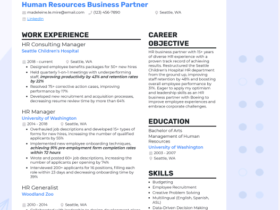What is the Correct Format for a curriculum vitae (CV); A curriculum vitae (CV) is a document that provides an overview of a person’s academic and professional accomplishments. It is often used in academic, medical, or scientific fields to apply for grants, fellowships, or jobs.
The format of a CV can vary depending on the field and the country, but there are some general guidelines to follow. In this article, we will explore the correct format for a CV and answer some frequently asked questions.

Key Takeaways
- A CV is a document that provides an overview of a person’s academic and professional accomplishments.
- The format of a CV can vary depending on the field and the country.
- A well-formatted CV should include personal information, education, work experience, and additional sections that are relevant to the field.
The first section of a CV should include personal information, such as the person’s name, address, phone number, and email address. The second section should include education, starting with the most recent degree earned. The third section should include work experience, starting with the most recent job held. Additional sections that may be included in a CV are publications, presentations, awards, grants, and professional memberships.
Frequently asked questions about CVs include how long it should be, what font to use, and whether to include a photo. The length of a CV can vary depending on the field and the country, but it should be concise and relevant to the job or grant application. The font should be easy to read, such as Times New Roman or Arial, and the photo is optional and may depend on the cultural norms of the country where the application is being submitted.
Personal Information
Personal information is an essential part of a CV and should be included in the beginning section. This information helps the recruiter to identify the candidate and contact them for further communication. The following are some of the personal details that should be included in a CV:
- Full Name: The candidate’s full name should be mentioned at the top of the CV. It should be in bold and larger font size than the rest of the text.
- Contact Information: The candidate’s contact information includes their phone number, email address, and location. It is important to ensure that the phone number and email address mentioned are correct and up-to-date. The location can be mentioned in the form of a city, state, or country depending on the candidate’s preference.
- Professional Title: The candidate’s professional title should be mentioned after their name. It should be in smaller font size than the name but larger than the rest of the text. The professional title could be the candidate’s current job title or the job title they are applying for.
- LinkedIn Profile: A link to the candidate’s LinkedIn profile can also be included in the personal information section. This provides the recruiter with additional information about the candidate’s professional experience and skills.
It is important to note that personal information such as age, gender, marital status, and religion should not be included in the CV. These details are not relevant to the candidate’s professional qualifications and could lead to discrimination.
Education
The education section of a CV is where the candidate lists their academic qualifications and certifications. This is a crucial section to include as it provides the hiring manager with an idea of the candidate’s educational background and their level of expertise.
Academic Qualifications
In the academic qualifications subsection, the candidate should list their highest level of education first. This could be a degree, diploma, or certificate. It is important to include the name of the institution, the degree/diploma/certificate title, and the year of graduation. If the candidate has multiple degrees, they should list them in reverse chronological order.
It is also important to include any relevant coursework or academic achievements. This will give the hiring manager an idea of the candidate’s academic strengths and areas of expertise. The candidate can list relevant coursework under each degree or in a separate section.
Certifications
In the certifications subsection, the candidate should list any professional certifications they have obtained. This could include certifications in a specific skill or trade, such as a Certified Public Accountant (CPA) or a Certified Project Manager (CPM). It is important to include the name of the certification, the certifying organization, and the date of certification.
Listing certifications can demonstrate the candidate’s commitment to their profession and their desire to continue learning and improving their skills. It can also help the candidate stand out from other applicants who do not have the same level of certification.
Overall, the education section of a CV should be clear, concise, and informative. It should provide the hiring manager with an understanding of the candidate’s educational background and their level of expertise. By including relevant academic qualifications and certifications, the candidate can demonstrate their commitment to their profession and their desire to continue learning and growing in their career.
Work Experience
The Work Experience section is one of the most important parts of a CV. It provides a detailed account of the candidate’s previous work history and highlights their professional background, skills, and competencies.
Professional Background
The Professional Background subsection of the Work Experience section should include the candidate’s work experience in reverse chronological order, starting with the most recent job. Each job should be listed with the following information:
- Job title
- Company name
- Employment dates
- Job description
It is important to include specific details about each job, such as job duties, responsibilities, and achievements. This helps the employer get a better understanding of the candidate’s skills and experience.
Skills and Competencies
The Skills and Competencies subsection of the Work Experience section should highlight the candidate’s key skills and competencies. This can include technical skills, soft skills, and transferable skills that are relevant to the job.
It is important to use bullet points to make this information easy to read and understand. The candidate should also use specific examples to demonstrate their skills and competencies.
Overall, the Work Experience section should provide a clear and concise overview of the candidate’s professional background, skills, and competencies. By following the correct format and including relevant information, the candidate can increase their chances of getting hired for the job they want.
Additional Sections
In addition to the essential sections of a CV, there are several optional sections that can be included to provide a more comprehensive picture of the candidate’s skills and experience. Here are a few examples of additional sections that can be added to a CV:
Publications and Presentations
If the candidate has published any articles, papers, or books, or has given any presentations at conferences or events, this section can be included to showcase their expertise and knowledge in their field. The section should include the title of the publication or presentation, the date, and the name of the publisher or organization.
Volunteer Work
Including a section on volunteer work can show the candidate’s commitment to their community and their willingness to give back. This section should include the name of the organization or cause, the dates of the volunteer work, and a brief description of the duties performed.
Hobbies and Interests
While this section is optional, it can provide insight into the candidate’s personality and interests. It can also be used to highlight skills or achievements that are not related to their professional experience. For example, if the candidate is an avid marathon runner, they could include this information to demonstrate their dedication and perseverance.
It is important to note that these additional sections should only be included if they are relevant to the position being applied for. If the candidate is applying for a job in a technical field, for example, they may want to include a section on their technical skills or certifications instead of their hobbies and interests.
Frequently Asked Questions
What are the essential sections to include in a CV for job applications?
A CV should include the following sections: personal details, professional summary or objective statement, work experience, education and training, skills, and references. These sections should be presented in a clear and concise manner, with relevant information that highlights the candidate’s suitability for the job.
How can students tailor their CV format to enhance their prospects?
Students can tailor their CV format by highlighting their relevant coursework, projects, and internships. They can also emphasize their transferable skills, such as communication, teamwork, and problem-solving. It is important to keep the CV concise and relevant to the job application.
What are the characteristics of an effective CV format?
An effective CV format should be clear, concise, and easy to read. It should highlight the candidate’s relevant skills and experience, and be tailored to the specific job application. It should also be well-organized, with headings and bullet points to break up the text.
In what ways should a CV be formatted to make a strong impression?
A CV should be formatted to make a strong impression by including a professional summary or objective statement at the beginning, highlighting the most relevant skills and experience, and using bullet points to break up the text. It should also be well-organized and easy to read, with a clear and concise writing style.
What guidelines should be followed when creating a CV in PDF format?
When creating a CV in PDF format, it is important to ensure that the document is properly formatted and easy to read. The font size should be at least 10 points, and the margins should be set to at least 1 inch on all sides. The document should be saved in PDF format to ensure that it can be opened and read by all potential employers.
Can you provide examples of CV formats suitable for various professional levels?
There are many different CV formats that are suitable for various professional levels. For entry-level positions, a chronological format that emphasizes education and training may be appropriate. For mid-level positions, a combination format that highlights both skills and experience may be more effective. For executive-level positions, a targeted format that emphasizes leadership and strategic thinking may be most appropriate.















Leave a Reply
View Comments